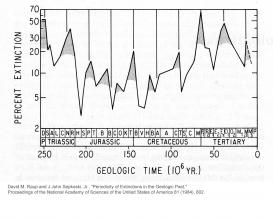This project is an intellectual and cultural history of extinction and biocultural diversity. I am currently writing a book, tentatively titled Catastrophic Thinking: Extinction and the Value of Diversity, which will be published by the University of Chicago Press. The book's central argument is that we can only fully appreciate why late-twentieth century culture became so invested in protecting and promoting diversity by more broadly investigating how ideas about biological and cultural extinction have changed over the past 200 years.
In the mid- to later nineteenth century, for example, diversity was simply not an independent value in scientific and political discourse in the West. It is possible to clearly trace how ideas about extinction, which was understood as a natural and inevitable process that supported a balance of nature by scientists like Charles Lyell and Charles Darwin, reinforced cultural attitudes about European imperialism that justified the exploitation and eradication of native peoples, flora, and fauna. The extinction of a biological species or a human culture was considered, essentially, to be the “fault” of that species—the result of natural selection. What scientific interest did exist in conserving natural wildlife was based mostly on elite, romantic values of aesthetics and recreation, and biological diversity was assumed to be self-replacing. However, beginning in the middle part of the twentieth century, new ideas about extinction that brought attention to the reality and significance of mass extinctions in the history of life changed both the scientific and political discourse surrounding extinction and diversity. The work of paleontologists and ecologists helped scientists understand that major mass extinction events had taken place many times in the earth’s past, and that these events—which sometimes saw as much as a 90 percent loss of standing diversity—had radical evolutionary and ecological consequences. Importantly, this created a field of study centered around the history of life’s diversity and diversification that was predictive and quantitative. One consequence of this new understanding of mass extinction and diversity was the realization that extinction, especially when triggered by external events (such as asteroid impact) was not always a process of competitive replacement—in other words, extinction was not necessarily the “fault” of the extinguished species.
The modern concern with the “biodiversity crisis” emerged directly from this new scientific understanding. It is often said that we are experiencing a “sixth extinction,” which is a reference to the five major mass extinctions in the geologic past documented by paleontologists, and paleontologists and ecologists have frequently participated in public and political discourse surrounding endangerment and conservation. What is especially significant is how the discourse of biodiversity emerged at the same time as a broader public awareness of threats to linguistic and cultural diversity. The first major biodiversity initiatives began in the mid-1980s, and had direct influence on, for example, UNESCO reports and workshops that began directly comparing biological and cultural diversity in the 1990s and 2000s. In fact, a new term was coined in the 1990s—“biocultural diversity”—which makes these links explicit. The broader cultural value of diversity is significantly informed by the new understanding of extinction and its consequences, but no historical account exists that explicitly brings these discourses together.

